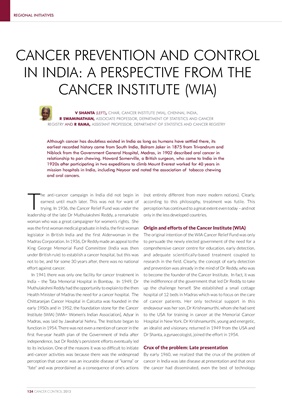
REGIONAL INITIATIVES
CANCER PREVENTION AND CONTROL
IN INDIA: A PERSPECTIVE FROM THE
CANCER INSTITUTE (WIA)
V SHANTA (LEFT), CHAIR, CANCER INSTITUTE (WIA), CHENNAI, INDIA,
R SWAMINATHAN, ASSOCIATE PROFESSOR, DEPARTMENT OF STATISTICS AND CANCER
REGISTRY AND R RAMA, ASSISTANT PROFESSOR, DEPARTMENT OF STATISTICS AND CANCER REGISTRY
Although cancer has doubtless existed in India as long as humans have settled there, its
earliest recorded history came from South India, Balram Jaker in 1875 from Trivandrum and
Niblock from the Government General Hospital, Madras, in 1902 described oral cancer in
relationship to pan chewing. Howard Somerville, a British surgeon, who came to India in the
1920s after participating in two expeditions to climb Mount Everest worked for 40 years in
mission hospitals in India, including Neyoor and noted the association of tobacco chewing
and oral cancers.
T
he anti-cancer campaign in India did not begin in (not entirely different from more modern notions). Clearly,
earnest until much later. This was not for want of according to this philosophy, treatment was futile. This
trying. In 1936, the Cancer Relief Fund was under the perception has continued to a great extent even today – and not
leadership of the late Dr Muthulakshmi Reddy, a remarkable only in the less developed countries.
woman who was a great campaigner for women’s rights. She
was the first woman medical graduate in India, the first woman Origin and efforts of the Cancer Institute (WIA)
legislator in British India and the first Alderwoman in the The original intention of the WIA Cancer Relief Fund was only
Madras Corporation. In 1936, Dr Reddy made an appeal to the to persuade the newly elected government of the need for a
King George Memorial Fund Committee (India was then comprehensive cancer centre for education, early detection,
under British rule) to establish a cancer hospital, but this was and adequate scientifically-based treatment coupled to
not to be, and for some 30 years after, there was no national research in the field. Clearly, the concept of early detection
effort against cancer. and prevention was already in the mind of Dr Reddy, who was
In 1941 there was only one facility for cancer treatment in to become the founder of the Cancer Institute. In fact, it was
India – the Tata Memorial Hospital in Bombay. In 1949, Dr the indifference of the government that led Dr Reddy to take
Muthulakshmi Reddy had the opportunity to explain to the then up the challenge herself. She established a small cottage
Health Minister of Madras the need for a cancer hospital. The hospital of 12 beds in Madras which was to focus on the care
Chittaranjan Cancer Hospital in Calcutta was founded in the of cancer patients. Her only technical support in this
early 1950s and in 1952, the foundation stone for the Cancer endeavour was her son, Dr Krishnamurthi, whom she had sent
Institute (WIA) [WIA= Women’s Indian Association], Adyar in to the USA for training in cancer at the Memorial Cancer
Madras, was laid by Jawaharlal Nehru. The Institute began to Hospital in New York. Dr Krishnamurthi, young and energetic,
function in 1954. There was not even a mention of cancer in the an idealist and visionary, returned in 1949 from the USA and
first five-year health plan of the Government of India after Dr Shanta, a gynaecologist, joined the effort in 1954.
independence, but Dr Reddy’s persistent efforts eventually led
to its inclusion. One of the reasons it was so difficult to initiate Crux of the problem: Late presentation
anti-cancer activities was because there was the widespread By early 1960, we realized that the crux of the problem of
perception that cancer was an incurable disease of “karma” or cancer in India was late disease at presentation and that once
“fate” and was preordained as a consequence of one’s actions the cancer had disseminated, even the best of technology
124 CANCER CONTROL 2013